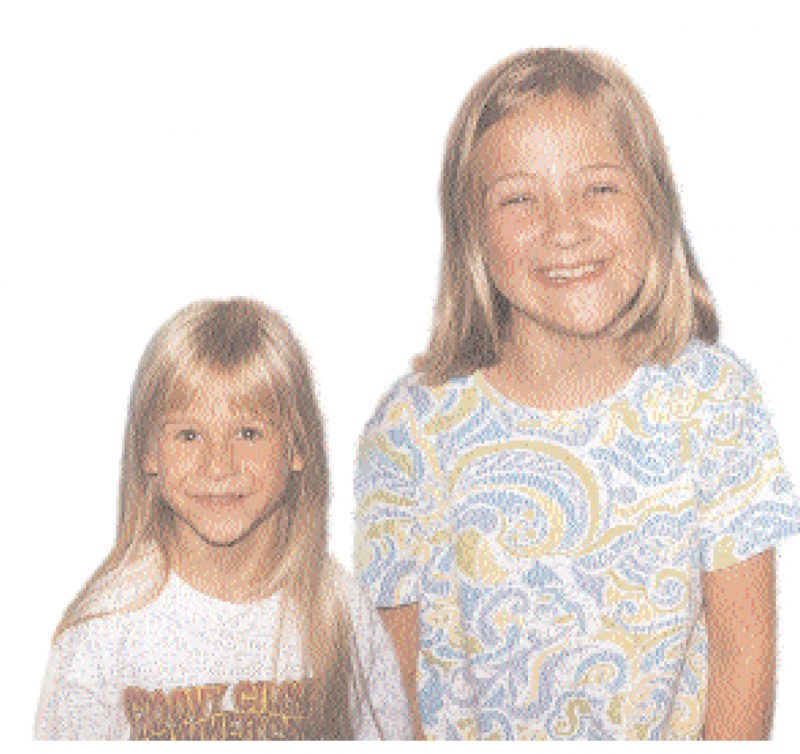The French girls, on the surface, appear carefree, perhaps even typical: young, blond, charming… concerned with the welfare of imaginary animals. So it’s all the more shocking to discover that this casual demeanor is all camouflage. These girls—eight-year-old Flannery and her younger sister Phoebe (age five)—are being stalked by the nefarious Barbara Doc Iveress (rhymes with “iris”). A master of disguises, Barbara Doc Iveress (aka BDI) is both a barber and a doctor, though you wouldn’t want to fall victim to her services. Not ever having spotted her, it’s easy to imagine she’s a relative of Cruella Deville.
“She’s like a trickster figure,” their father explains. “Phoebe thought her up.”
“If you want to be bald,” Phoebe says, “she just cuts off a few strings of your hair.” Phoebe’s hair is long and very straight with bangs that suggest a sophistication uncommon in five-year-olds.
“And if you don’t want to be bald,” Flannery adds, “she makes you bald.” Flannery has recently let her hair grow out into a 1930s style bob.
“She recommends all the wrong medicines,” Phoebe continues, with a bit of respectful glee. Or perhaps it is delight in having conjured up this evil.
“We’ll forget about her for a week,” their father says, “and then we’ll be in public and Phoebe will catch my eye, gesture toward someone she doesn’t like the looks of, and whisper: Barbara Doc Iveress.”
“She steals kids’ things,” Flannery says, in a voice the poet David Kirby has compared to Lauren Bacall. “She drives around in her car and she follows us everywhere.”
Theirs is a house that unmistakably belongs to the children. The living room is divided by a partition on one end, behind which is the designated play area, as if such a thing could be contained. Today the action is in the living room proper—which now appears to be the waiting area of a veterinary clinic. The animals (stuffed, collected from their own toy collection) are lined up on the floor, grouped in a triage system that appears to be based on size, color and species. On second thought, they might also be preparing to board an invisible ark. But all of these guesses are wrong. It is a pet shop. Earlier, they played a game in which Flannery was ten instead of eight.
The girls are eager to lead a tour of the house, which seems to them to consist only of their individual bedrooms. Though they share a fondness for the creative application of small stickers—on the bedroom doors, on their dressers, throughout the back half of the disabled station wagon in the drive—there are distinctions. Flannery’s room is decorated with animals. Animals everywhere. Posters, cutout magazine pictures, an extensive horse collection, and, a more recent interest, Altoids tins. Phoebe’s room continues the sticker-and-animal theme—Scooby Doo is a favorite—but being the younger, she’s about 30 percent behind in her collections. The result is more minimalist, drawing more attention to the American Girl memorabilia, which is actually split evenly between the two.
Next, there are vacations to talk about, more memorable, it seems, for who got sick. This summer it was Midwestern caves and stomach flu, though there is debate about which of the girls had more eruptions. When their mother arrives home, she scans the debris of the day’s play with measured indifference. Both of their parents are writers and university professors. “But,” Flannery confides, “I think they like just writing better.”
Flannery takes her mother aside for a consultation. Is it something about school, or is she offering her mom some career counseling? Meanwhile, briefly overcome with fatigue, Phoebe drapes herself across a chair in the living room. “I had no idea it would be this much fun,” she says of her first interview, which has now concluded.





